On Set For ‘The Shape Of Water’: Guillermo Del Toro “Bled” To Realize His Most Ambitious Project Yet

文章转载自:UniFi影视完片担保
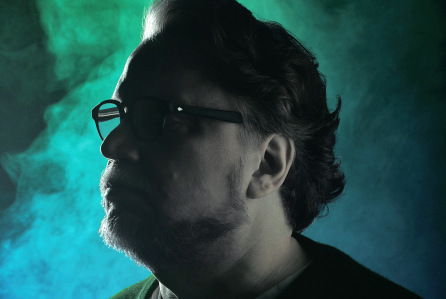
Dan Doperalski for Deadline
Guillermo del Toro is taking a breath. It probably feels like his first in 12 months. It is a hot summer’s day on the Lido in Venice, and his latest film, The Shape of Water, is tonight’s film festival premiere. From the outside, this past year for the Mexican writer and director has looked pretty good. The animated kids series he produced, Trollhunters, has become an unbridled hit for Netflix; Season 2 is already on order. And few directors, even visionary ones like del Toro, get to claim sold-out exhibition runs at LACMA, yet del Toro’s “At Home With Monsters” has been doing gangbuster business all year. A curated selection of all the trinkets and artwork del Toro has collected over a lifetime dedicated to the macabre, the exhibition is readying for a tour that will take it to Minneapolis, Toronto and Mexico City. Then he’ll bring it all home. “I want my shit back,” he joked on Twitter.
Related
Tonight, though, del Toro will face his greatest test. Not only is he premiering his first feature film since 2015’s Crimson Peak, but the movie he is about to show the Biennale has been gnawing away inside him for more than 20 years. Can a human being fall in love with a monster? It’s a question del Toro has been asking himself his whole life; the question that has driven him to become Propagandist-in-Chief for monster-kind ever since he was a kid.
The Shape of Water is his emphatic answer in the affirmative, but he is nervous. Uncertain of how the public will respond to his unconventional fetish. “I think the movie is very beautiful, and it connects emotionally with me,” del Toro reflects. “With a bit of luck, people will connect with it. But, demographically, it’s going to rub some people the wrong way. It’s an antidote to cynicism—a movie that wears its heart on its sleeve. To some people that will be moving. Others will find it coy.”
A little under a year earlier, and del Toro is sitting by a bank of monitors tucked into the corner of a vast NASA-like control center set. The walls are decorated with a Pop Art tiled mosaic celebrating all things astronautic; giant rockets blasting into space—or perhaps missiles aimed at America’s enemies. The colors are subdued; sickly pastels on every surface. Queasy Green. Infirmary Blue. Malaise Marigold. At ’60s-era workstations, scientist-types in white shirts with pocket protectors and thick-rimmed glasses pace restlessly. In one corner, a small woman in a janitor’s smock minds her own business, slowly dancing with a mop.
On the set of The Shape of Water, del Toro is in his element, presiding over the filming of a script that demanded and defines every ounce of himself. When a crewmember passes by in a Universal Monsters t-shirt, del Toro stops him to enthuse about it. After the exchange, I idly ask the director what it is with him and monsters. Del Toro says nothing; he simply whistles as he raises his index finger skyward, erect.
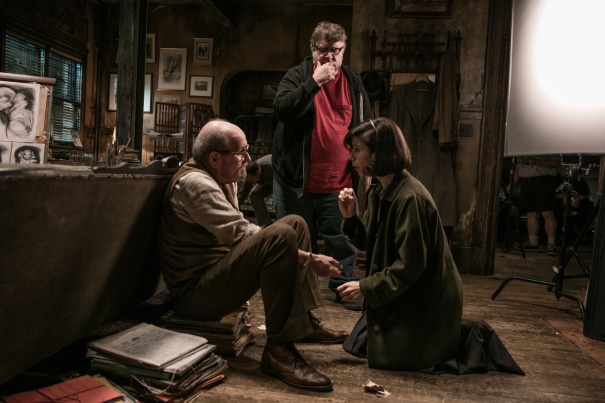
What led del Toro here—to a ribald gesture on a Canadian soundstage—started life sometime in the 1990s. He was a young man then, not long into his 30s. His debut feature, Cronos, had premiered at Critics Week in Cannes, and he was flirting with which direction to take next. He alighted on an idea to tell the tale of an amphibian being who falls in love with a human woman. He had always identified with monsters. As a kid, his love for the macabre was an escape that didn’t jive with the strict Catholic background he was brought up in at home in Guadalajara. His grandmother literally tried to exorcize the demons out of him; twice. “It definitely didn’t take,” he joked. He empathized with the lot of the unloved and the feared. Monsters were always misunderstood, which was just how he felt. This idea was his way of rewriting their history.
“It was a Victorian creature expedition about explorers that go to the Amazon,” he says. “I wanted to do a movie about an amphibian creature who changes the life of whoever rescues it, in a magical way.” It was loosely inspired by a favorite fairy tale collected by the Grimm brothers—about a flounder that grants wishes for a fisherman and his wife—with a touch of Beauty and the Beast and The Little Mermaid. Nobody was biting; the project never got off the ground.
Instead his first foray into Hollywood filmmaking would be Mimic, about man-sized cockroach creatures who terrorize the New York Subway. It was more in keeping with the status quo: monsters bad, humans good. Del Toro had a miserable experience making the movie, which was produced by Dimension Films—Bob and Harvey Weinstein. The irony of recent news reports doesn’t escape him. “Two horrible things happened in the late ’90s,” he told an audience at the London Film Festival earlier this year. “My father was kidnapped and I worked with the Weinsteins… The kidnapping made more sense; I knew what they wanted.”
Del Toro would right his ship, first by returning to the Spanish language with The Devil’s Backbone, and then to Hollywood once more, for Blade II and Hellboy. But it was Pan’s Labyrinth, in 2006, that elevated him to directing’s A-List. It became Mexico’s submission for that year’s Best Foreign Language prize at the Academy Awards and went on to pick up that nomination, as well as five more—ultimately claiming three Oscars. Del Toro was personally nominated (but didn’t win) in the Original Screenplay category, and he soon joined his countrymen Alfonso Cuarón and Alejandro González Iñárritu (they would be nicknamed “The Three Amigos”) on everybody’s “Must Work With” list.
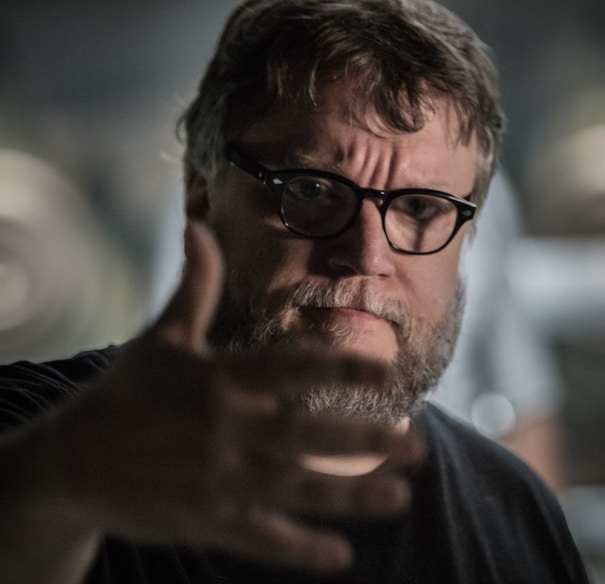
Somehow though, in the decade that followed, del Toro made just three features—Hellboy II, Pacific Rim and Crimson Peak. Each of them burned as brightly within him as anything had, but so too did a scorched earth of projects that never made it past the drawing board. “Guillermo del Toro’s unrealized projects” is one of Wikipedia’s sturdier entries. “I do contemplate how many times you can give your blood to this particular brother, which is cinema,” del Toro says now. “In my case, I have bled quite a lot.”
Among the projects that hemorrhaged, he spent years working on a two-picture adaptation of The Hobbit, but endless delays caused by MGM’s precarious financial situation forced him to depart; Peter Jackson would wind up directing his own trilogy. His efforts on Mary Shelley’s Frankenstein—the countless hours he has spent turning it into a feature film that honored the book—are so far for naught. “I always think the best ones are the ones I never got to make,” he laughs. “Like Beauty and the Beast and The Count of Monte Cristo.”
Then there’s the long-fought battle of adapting one of his favorite H.P. Lovecraft stories, At the Mountains of Madness. He came close to mounting it with Universal before the studio balked at the $150 million budget for a movie that del Toro wanted the latitude to make R-rated—even with Tom Cruise signed up to star.
“I would say there’s a chance of a different version of that movie existing,” is all he will concede now. “But the industry is shifting and it’s very hard to predict where it’s going to go. There are massive tectonic plates moving, and big consolidations are going to create a clash of the titans. Where we land in what stories we can tell, and what formats are left, I don’t know.”
Del Toro has suffered those tectonic shifts greater than most. Pacific Rim limped into release just after Legendary, who had made the movie, pacted with Universal after a long run with Warner Bros. Warners released it without any incentive to support its release, and it scraped its way to a $411 million worldwide gross on a $190 million budget.
The ground was even less steady when del Toro was making Crimson Peak. Its yet more dispiriting box office led him to a realization about how the world had changed. “If I’d done Crimson Peak for $25 million, the movie would have been a success because it made $75 million,” he says. “But because I made it for $50 million, it wasn’t a success because it needed to do $150 million.”
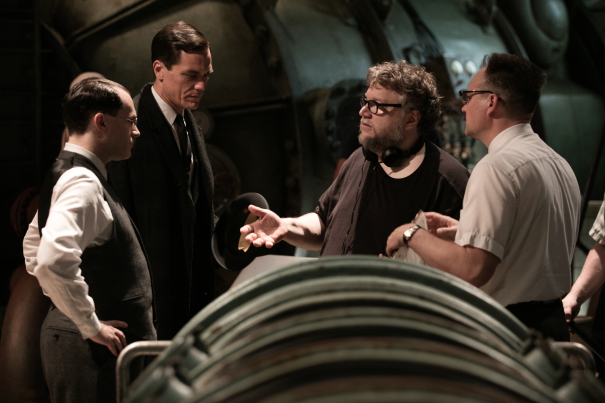
It was while he was prepping Pacific Rim that a chance disclosure over breakfast flagged an opportunity to return to his amphibian love story. He was sitting with Daniel Kraus, the author with whom he was co-writing Trollhunters. Kraus told him that he, too, had an idea for a story about an aquatic creature. “He said, ‘It’s about this secret government keeping an amphibian creature, and this janitor befriends him,’” del Toro recalls. “I said, ‘Say no more. I’m buying the idea from you; don’t write anything.’”
It was the breakthrough del Toro needed to start writing. His thoughts came thick and fast. He would set it in 1962, at the end of the idealized American dream. “Vietnam is in swing, Kennedy’s about to be assassinated, and everyone thought the future would be great. It’s the moment where things start to change. I thought it would be a great moment for something primitive and spiritually powerful to exist.”
He wrote 30 pages. “And then I got stuck,” he says. He showed his work to Vanessa Taylor, the screenwriter behind Divergent and episodes of Game of Thrones and Alias. “She introduced the Russian restaurant idea and fleshed out the idea of the spies. That’s when it became a movie.”
Over five years the script carefully came together, and principal characters emerged. There was Elisa, the janitor who lost her voice as a child and would lose her heart to the creature; Elisa’s fellow janitor Zelda, a black woman dealing with the prejudices of a city so far untouched by the Civil Rights movement; and Elisa’s neighbor, Giles, a gay advertising artist whose hand-painted method is quickly becoming extinct, and yet he’s still too early to land in a world that will accept his sexuality. Then there’s Michael Stuhlbarg’s Dr. Robert Hoffstetler, a Russian double agent unable to convince either of his paymasters of the scientific beauty of the creature they are conspiring to kill and cut open.
These characters are all societal outcasts; others. They are practically invisible; marginalized by a world that doesn’t care to see them. It’s hard not to draw the parallels, which ran through del Toro’s mind as he wrote, with a modern-day political climate that is similarly shunning those it chooses not to understand.
“Elisa is born in a place that she doesn’t quite belong in,” says del Toro. “She’s cleaning toilets and picking up garbage. Nobody sees her. She finds a place where she belongs and a person that shows her who she is, and not by dictating.”
He wrote the parts with actors in mind—Sally Hawkins for Elisa, Octavia Spencer for Zelda and Richard Jenkins for Giles. They were all willing; excited, even. In fact, Hawkins was more prepared for his call than del Toro could know. She had been writing her own story about a woman who didn’t know she was a mermaid. She and del Toro found the coincidence serendipitous. “It was so beautiful that we were on the same wavelength,” del Toro says. “I asked her if I could use this idea that she had scars on her neck that turned out to be gills. She allowed me to use another detail she had, which was that the character used a lot of salt to make the water in her bathtub habitable.”
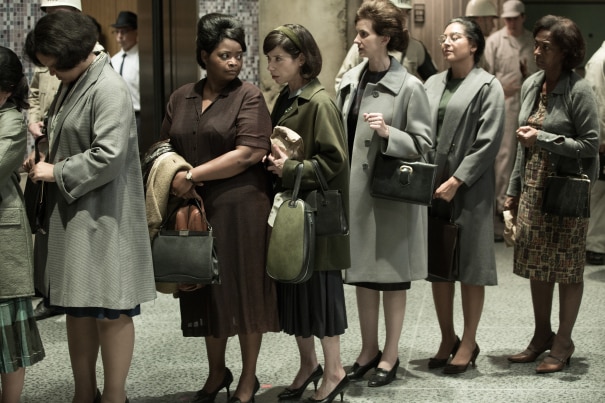
The film may be set in ’62, but del Toro’s design for it evokes an earlier period of Hollywood dream-making. “It felt like a film made in the late ’30s, early ’40s,” says Jenkins. “It’s the feel of one of the great masters; Frank Capra does a genre picture.”
But in a movie of that era, the hero would not be Elisa, nor the amphibian object of her desires. The hero, instead, would be security chief Strickland, a part written for Michael Shannon. After all, he’s the all-American alpha male who captures and subjugates the creature, dragging it halfway across the planet to be poked and prodded and used; squeezed for whatever information it could be carrying that might benefit his own interests. He’s the shoot-first-and-ask-questions-later type, determined to flex his masculinity and overstate his dominance for any who will pay attention. He deludes himself that he’s keeping us all safe from the threat of this ungodly demon, as he grasps at the higher rungs on his own career ladder.
“I don’t like writing bad guys, and Strickland is not the bad guy,” del Toro insists. “In the purest terms, he’s the antagonist. The antagonist can be a character that is as complex and compelling as the hero.” And so he is, played with zeal by Shannon; Strickland’s proselytizing covers up an unhappy home life with his stuck-in-the-’50s nuclear family and a sense that he belongs to bigger and better things than are offered by the cards he has currently been dealt.
Each of the characters represents something within del Toro. He knows how to write outsiders because it’s how he feels inside. “My youngest daughter told me, ‘I can see you in the amphibian man and I can see you in Elisa,’” he recalls. “I write them like that. Even the conversation Shannon has with the general is a conversation I’ve had with producers or studio heads at one time or another.” In the scene, Strickland begs his superior for reassurance. “When is a man done, sir, proving himself?”
As the script developed, it got very specific, in a way that has become del Toro’s hallmark. It references a playlist of musical numbers he painstakingly selected. When he needed a classic movie about a woman in love with her god, to play in the movie theater beneath Elisa’s apartment, he dipped into the expansive archives of 20th Century Fox, whose Searchlight wing looked the likeliest to produce The Shape of Water, and he found a nice obscure one called The Story of Ruth. “I saw a lot of bad movies and a lot of good movies,” he says. “I wanted to choose carefully, things that were not popular.”
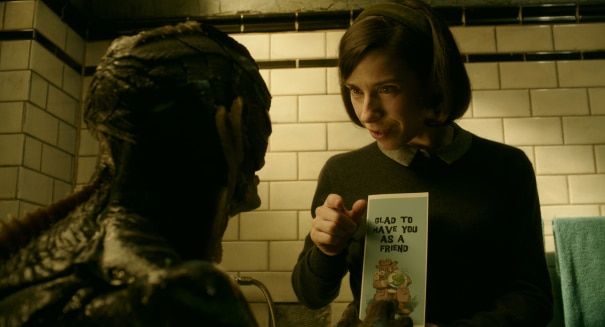
This was as much about economizing as it was about design. The experiences on Pacific Rim and Crimson Peak had steeled him for a reality in which those tectonic shifts would ensure his budget would not be bottomless. “It was clear to me that Shape needed to cost under $20 million.” Del Toro wanted to buy the freedom he needed to tell the story in his own way, without compromise or outside interference. The song and movie choices fell to things Fox controlled the rights for because he knew he couldn’t afford to pay for them. And before Searchlight officially came on board, del Toro had already pre-scouted Toronto, an adoptive home to him after production on Pacific Rim and Crimson Peak had been based there. It also meant making his personal investment financial as well as emotional. He sank hundreds of thousands of his own dollars into designing a creature that was almost completely conceptualized before the greenlight ever arrived.
All of this work was designed to make the project undeniable. To prove to himself, but more importantly to a studio partner, that he could turn the film around without needing additional funds. At Fox Searchlight, he found a home willing to give him the space required to deliver the picture in his head, but the final budget figure would not exceed $19.5 million. “Pan’s Labyrinth cost the same as The Shape of Water, and Shape is much, much bigger in scale than Pan’s,” del Toro sighs.
But even with a tight budget, the director knew that getting the creature right would be his ultimate test. What mattered more than anything was ensuring the movie’s eventual audience would have as little trouble falling in love with a seven-foot-tall fish-man as del Toro had. “We went through great extremes,” he says. “We wanted to create the perfect swimmer body; almost like a Greek statue. When we designed the fin pattern, the layout of the abdominal plate, the musculature on the chest and arms, all of it was done to make something beautiful. The lips were beautiful but not exaggerated. We tried to keep the eyes expressive. There’s a harmonious balance to strike.”
I’m present on set for one of the creature’s first scenes. All morning, crewmembers have been working on projection effects to make it appear that a tall section of glass tubing in a dark, dank sub-basement laboratory contains deep water. In a trailer nearby, Doug Jones—who has played nearly a dozen invented beings for del Toro over the years, starting with Mimic in 1997—is suiting up; a process that takes several hours.
There was never a question in del Toro’s mind about putting a man into this creature’s body. When he’d been designing Hellboy he had consulted with his friend, director James Cameron, about using a puppet. Cameron had a rule: a puppet can fall in love with another puppet, but a puppet can’t fall in love with a human. The same was true here, he knew. “It needed a human inside because of the nuance of the characters looking at one another,” del Toro says. “It needed a lot of things that only Doug can deliver.”
A call goes out on the set walkie-talkies. “Bring in Charlie.” This is a del Toro wheeze; his creature is never given a name in the final film—merely “the asset”—but Jones’s character is called “Charlie” on the call-sheet by reference to the StarKist mascot Charlie the Tuna. “We wanted to play the ad on TV,” he says, “but StarKist didn’t want to have anything to do with a movie like this. The nickname stayed.”
There’s plenty of anticipation for Charlie’s first arrival. As final checks happen, I find myself in front of the creature’s tank as Jones takes his position. We lock eyes and, perhaps for my benefit, Jones transforms into del Toro’s creation. It’s an uncanny moment; the actor underneath seems to disappear as this marine god takes his place. “The same thing happened with Richard Jenkins,” del Toro says later. “He was on set with Doug in full costume, and Doug was drinking coffee and eating a bagel. He was like, ‘Oh god, this is going to be a disaster.’ And then Doug gets into the bathtub, I call action, and he immediately transformed into the creature.”
Still, laughs Jenkins, “It was funny to tease Doug. ‘Have you tried acting without all that make-up on? Here, have more food, Doug. Let’s see if you can still fit into the suit when you’re 10lbs heavier.’”
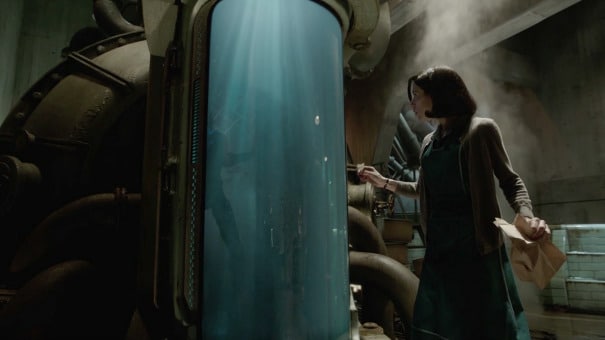
Soon we’re ready to shoot; a scene in which Elisa gets her first real look at the creature in the basement. Their gazes meet for a beat longer than seems to make sense to either of them, and then, distracted by a noise, the creature flutters back into the recesses of its tank. “By take seven it was very hard to see,” del Toro tells me the next day. “My glasses had completely fogged up. I get very emotional. It was the same with Pan’s Labyrinth and The Devil’s Backbone.”
In the week I spend on set, I am witness to the ingenuity and frustration of keeping a production this ambitious on track. The studio space del Toro is working on is also home to his FX series The Strain (Shape is shooting in its off-season). Producer J. Miles Dale—also an EP on The Strain—tours me around the various sets, pointing out how del Toro’s movie has even reconfigured several of the stage builds from the show for its own purposes.
And yet, every blown take and unwanted interruption engenders a spirit of disappointment in a crew fighting to make each shot count. When a PA opens a door into the middle of a scene between Michaels Shannon and Stuhlbarg, believing he heard “cut”, del Toro sinks in his seat. The PA is forgiven, of course, but it’s another quarter hour lost to a production skirting on the edge of the red.
“That was a difficult movie, man,” is the first thing del Toro says to me, a year later in Venice, as he thinks back on the production. “The days are running under you like a sandstorm. It’s a high-pressure situation because it’s a movie delivered under a very tight budget and a very tight schedule, with a margin for error that is almost zero.”
When the lights go down in the Sala Grande later that same evening, del Toro is sat with his cast to watch the film play to an outside audience for the very first time. When they come back up, two hours later, the room explodes with shouts of “bravo”, and an ovation begins that will not cease until del Toro leaves the theater, 10 minutes later. As he first rises to take his applause, tears well in his eyes. He turns to Hawkins, hugs her warmly, and then lifts her up into the air. He is elated.

A week later, The Shape of Waterreceives the Golden Lion, the festival’s highest prize; it’s the start of a journey that rolls on to Telluride, Toronto, and an early December release. “That screening in Venice was one of my favorite nights in a 25-year career,” he’ll tell me later. “And I’ve felt the same way in screening after screening. It doesn’t go away. It never goes away.”
Having an audience connect with his work is the manna that fuels Guillermo del Toro. “That’s the satisfaction. The rest is posterity.” And it has come from his own connection to the work he chooses; there is nothing impersonal about a single project del Toro has taken on. He may have learned, over the years, not to share too much too soon, as ideas have developed and collapsed like precarious blancmange. But he’s certainly learned to fight for what he believes in: that differences are not to be feared, and that the truest monsters aren’t necessarily mythical beasts. His movies deify those who believe in goodness and love, because he does as well. There are no more powerful forces to del Toro.
That does not mean he is naïve to the harshness of an industry that would deny such optimism—if not in the art it creates, then certainly in the business of its creation. “I don’t know any other place than Hollywood that generates as much friction and pain,” he says. “It is the desire of the storyteller to mold the world in some manner. And that appetite is conducive to a lot of disappointment in an industry that is a very, very uncertain marriage of business and artistry. It wears you down, and the business part of it is almost infallibly crass, to say the least. You need to find your strength again in the stories.”
For del Toro, as much as there will always be further stories he’s burning to tell, being grateful for the ones he has already told is what keeps the spark within him alive. “Honestly, if you told me right now, ‘Guillermo, time for you to go buy a little cabin by the sea and fish,’ I would go; I have no problem. After The Shape of Water—after everything I’ve done—I’m satisfied. I’ve made 10 more movies than I ever thought I would make.”
Subscribe to Deadline Breaking News Alerts and keep your inbox happy
